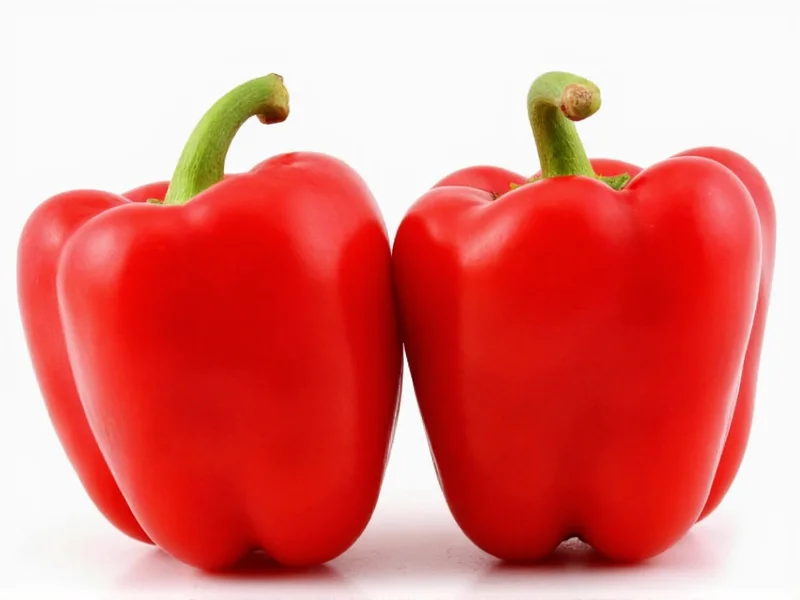Many home cooks and grocery shoppers wonder are red bell peppers hot when they see these vibrant vegetables alongside spicy varieties. The straightforward answer is no—they're among the mildest peppers you can eat, registering 0 on the Scoville scale, which measures pepper heat.
Understanding Bell Pepper Heat Levels
All bell peppers—regardless of color—are members of the Capsicum annuum species but belong to a specific cultivar group bred specifically to lack capsaicin. This distinguishes them from their spicy cousins like jalapeños, habaneros, and cayenne peppers.
The absence of capsaicin in bell peppers results from selective breeding over centuries. While wild pepper varieties developed capsaicin as a defense mechanism against predators, bell peppers were cultivated for their thick walls, crisp texture, and sweet flavor—qualities that made them ideal for culinary use without adding heat.
| Pepper Type | Scoville Heat Units | Flavor Profile |
|---|---|---|
| Red Bell Pepper | 0 SHU | Sweet, fruity, slightly grassy |
| Green Bell Pepper | 0 SHU | Grassy, slightly bitter |
| Jalapeño | 2,500–8,000 SHU | Grassy, vegetal, moderately hot |
| Habanero | 100,000–350,000 SHU | Fruity, floral, extremely hot |
Why Red Bell Peppers Aren't Hot: The Science
The heat in peppers comes exclusively from capsaicinoids, primarily capsaicin, which activate TRPV1 receptors in your mouth that detect heat and pain. Bell peppers lack functional genes that produce capsaicin, making them incapable of creating this compound.
Interestingly, red bell peppers are simply mature green bell peppers. As they ripen from green to red on the plant, their flavor profile changes significantly:
- Green bell peppers are harvested early and have a more bitter, grassy flavor
- Red bell peppers stay on the vine longer, developing higher sugar content (nearly 9% more than green) and lower bitterness
- Nutritionally, red bell peppers contain nearly 11 times more beta-carotene and 1.5 times more vitamin C than their green counterparts
Common Misconceptions About Red Bell Peppers
Several factors contribute to the confusion about are red bell peppers spicy:
- Color association: Many hot peppers (like cayenne and red jalapeños) are red, leading people to assume all red peppers are spicy
- Supermarket labeling: Some stores place bell peppers near hot varieties without clear differentiation
- Culinary context: Red bell peppers often appear in dishes with spicy ingredients, creating false associations
- Rare mutations: Extremely uncommon bell pepper varieties might develop slight heat due to genetic reversion, but this is exceptional
Practical Uses for Red Bell Peppers
Understanding why are red bell peppers not hot helps home cooks use them effectively:
- Raw applications: Their sweetness shines in salads, crudités, and sandwiches
- Cooking methods: Roasting enhances their natural sugars, while stir-frying maintains crispness
- Flavor pairing: Complements garlic, herbs, tomatoes, and citrus; balances spicy ingredients
- Substitution: Can replace sweet paprika in recipes when fresh ingredients are preferred
When selecting red bell peppers, look for firm, glossy skins with deep color. Avoid those with wrinkles or soft spots, which indicate aging. Store them in the refrigerator's crisper drawer for up to two weeks.
Bell Peppers vs. Hot Peppers: Key Differences
While both belong to the nightshade family, bell peppers and hot peppers differ significantly:
- Genetic makeup: Bell peppers have a recessive gene that prevents capsaicin production
- Internal structure: Bell peppers have three or four lobes and thick walls; hot peppers typically have thinner walls
- Seeds and membranes: In hot peppers, these contain most capsaicin; bell peppers have uniform mildness throughout
- Culinary role: Bell peppers add flavor and texture without heat; hot peppers primarily provide spiciness
FAQ
Are all colors of bell peppers equally mild?
Yes, all bell pepper colors (green, yellow, orange, red, purple, and brown) contain zero capsaicin and are equally mild. The color difference comes from ripeness stage and affects sweetness and nutritional content, not heat level.
Can red bell peppers ever be spicy?
Under normal circumstances, no. True bell peppers never contain capsaicin. Rare genetic mutations might cause minimal heat in exceptional cases, but this would be unusual and not characteristic of standard commercial varieties.
Why do some people think red bell peppers are hot?
This misconception often comes from associating red color with spicy peppers (like red jalapeños or cayenne), confusion with other red peppers at grocery stores, or experiencing dishes where red bell peppers were cooked alongside hot ingredients.
What's the difference between red bell peppers and pimentos?
Pimentos are a specific variety of mild chili pepper (not bell peppers) with a Scoville rating of 100-500 units—barely detectable. They're smaller, heart-shaped, and slightly sweeter than bell peppers, but both are considered mild compared to truly hot peppers.
How can I tell if a red pepper is a bell pepper or a hot variety?
Bell peppers have a blocky, rectangular shape with three or four lobes at the base, thick walls, and a sweet aroma. Hot red peppers are typically narrower, have thinner walls, and may show signs of heat potential like pointed tips or smoother skin. When in doubt, check the stem—it should be green on bell peppers.











 浙公网安备
33010002000092号
浙公网安备
33010002000092号 浙B2-20120091-4
浙B2-20120091-4